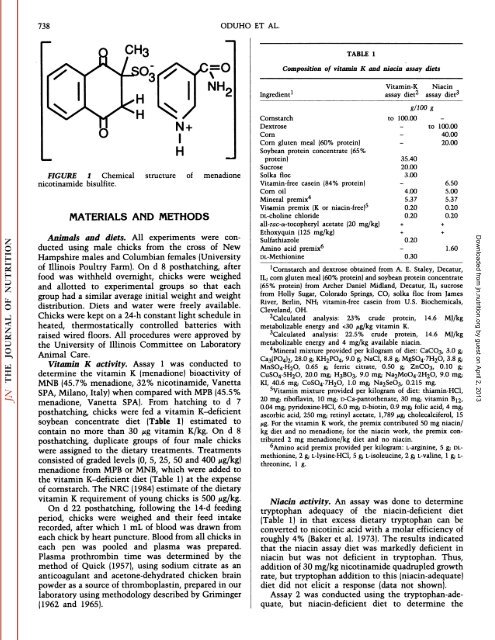Menadione Nicotinamide Bisulfite Is a Bîoactîve Source of ...
Menadione Nicotinamide Bisulfite Is a Bîoactîve Source of ...
Menadione Nicotinamide Bisulfite Is a Bîoactîve Source of ...
Create successful ePaper yourself
Turn your PDF publications into a flip-book with our unique Google optimized e-Paper software.
738 ODUHO ET AL.<br />
FIGURE 1 Chemical structure <strong>of</strong> menadione<br />
nicotinamide bisulfite.<br />
MATERIALS AND METHODS<br />
Animals and diets. All experiments were con<br />
ducted using male chicks from the cross <strong>of</strong> New<br />
Hampshire males and Columbian females (University<br />
<strong>of</strong> Illinois Poultry Farm). On d 8 posthatching, after<br />
food was withheld overnight, chicks were weighed<br />
and allotted to experimental groups so that each<br />
group had a similar average initial weight and weight<br />
distribution. Diets and water were freely available.<br />
Chicks were kept on a 24-h constant light schedule in<br />
heated, thermostatically controlled batteries with<br />
raised wired floors. All procedures were approved by<br />
the University <strong>of</strong> Illinois Committee on Laboratory<br />
Animal Care.<br />
Vitamin K activity. Assay 1 was conducted to<br />
determine the vitamin K (menadione) bioactivity <strong>of</strong><br />
MNB (45.7% menadione, 32% nicotinamide, Vanetta<br />
SPA, Milano, Italy) when compared with MPB (45.5%<br />
menadione, Vanetta SPA). From hatching to d 7<br />
posthatching, chicks were fed a vitamin K-deficient<br />
soybean concentrate diet (Table 1) estimated to<br />
contain no more than 30 /¿gvitamin K/kg. On d 8<br />
posthatching, duplicate groups <strong>of</strong> four male chicks<br />
were assigned to the dietary treatments. Treatments<br />
consisted <strong>of</strong> graded levels (0, 5, 25, 50 and 400 /¿g/kg)<br />
menadione from MPB or MNB, which were added to<br />
the vitamin K-deficient diet (Table 1) at the expense<br />
<strong>of</strong> cornstarch. The NRC (1984) estimate <strong>of</strong> the dietary<br />
vitamin K requirement <strong>of</strong> young chicks is 500 Mg/kg.<br />
On d 22 posthatching, following the 14-d feeding<br />
period, chicks were weighed and their feed intake<br />
recorded, after which 1 mL <strong>of</strong> blood was drawn from<br />
each chick by heart puncture. Blood from all chicks in<br />
each pen was pooled and plasma was prepared.<br />
Plasma prothrombin time was determined by the<br />
method <strong>of</strong> Quick (1957), using sodium citrate as an<br />
anticoagulant and acetone-dehydrated chicken brain<br />
powder as a source <strong>of</strong> thromboplastin, prepared in our<br />
laboratory using methodology described by Griminger<br />
(1962 and 1965).<br />
Ingredient1<br />
TABLE 1<br />
Composition <strong>of</strong> vitamin K and niacin assay diets<br />
Cornstarch to<br />
Dextrose<br />
Corn<br />
Corn gluten meal (60% protein)<br />
Soybean protein concentrate (65%<br />
protein)<br />
Sucrose<br />
Solka floe<br />
Vitamin-K<br />
assay diet2<br />
100.00<br />
35.40<br />
20.00<br />
g/100 g<br />
3.00<br />
Niacin<br />
assay diet3<br />
to 100.00<br />
40.00<br />
20.00<br />
Vitamin-free casein (84% protein) 6.50<br />
Corn oil 4.00 5.00<br />
Mineral premix4 5.37 5.37<br />
Vitamin premix (K or niacin-free)5 0.20 0.20<br />
DL-choline chloride 0.20 0.20<br />
all-rac-a-tocopheryl acetate (20 mg/kg) + +<br />
Ethoxyquin (125 mg/kg) + +<br />
Sulfathiazole 0.20<br />
Amino acid premix6 1.60<br />
DL-Methionine 0.30<br />
1Cornstarch and dextrose obtained from A. E. Staley, Decatur,<br />
IL; corn gluten meal (60% protein) and soybean protein concentrate<br />
(65% protein) from Archer Daniel Midland, Decatur, IL; sucrose<br />
from Holly Sugar, Colorado Springs, CO; solka floe from James<br />
River, Berlin, NH; vitamin-free casein from U.S. Biochemicals,<br />
Cleveland, OH.<br />
Calculated analysis: 23% crude protein, 14.6 MJ/kg<br />
metabolizable energy and
















